Monash University EDF5024 - Model of Play, Observation & Analysis
VerifiedAdded on 2022/12/29
|8
|2622
|33
Report
AI Summary
This report presents a model of play emphasizing planning, engagement, structured activities, and sustained shared thinking. It integrates theoretical concepts like Zone of Proximal Development and collective imagination, using a socio-dramatic play example of a 'hospital' to illustrate practical application. The pedagogical role focuses on pre-assessment, reflective practice, and fostering self-perception and collaborative behavior. The model aims to achieve sustainable cognitive, social, emotional, and physical development in children through contextual learning and real-life simulations. Evaluation by educators is crucial for ongoing support and development.
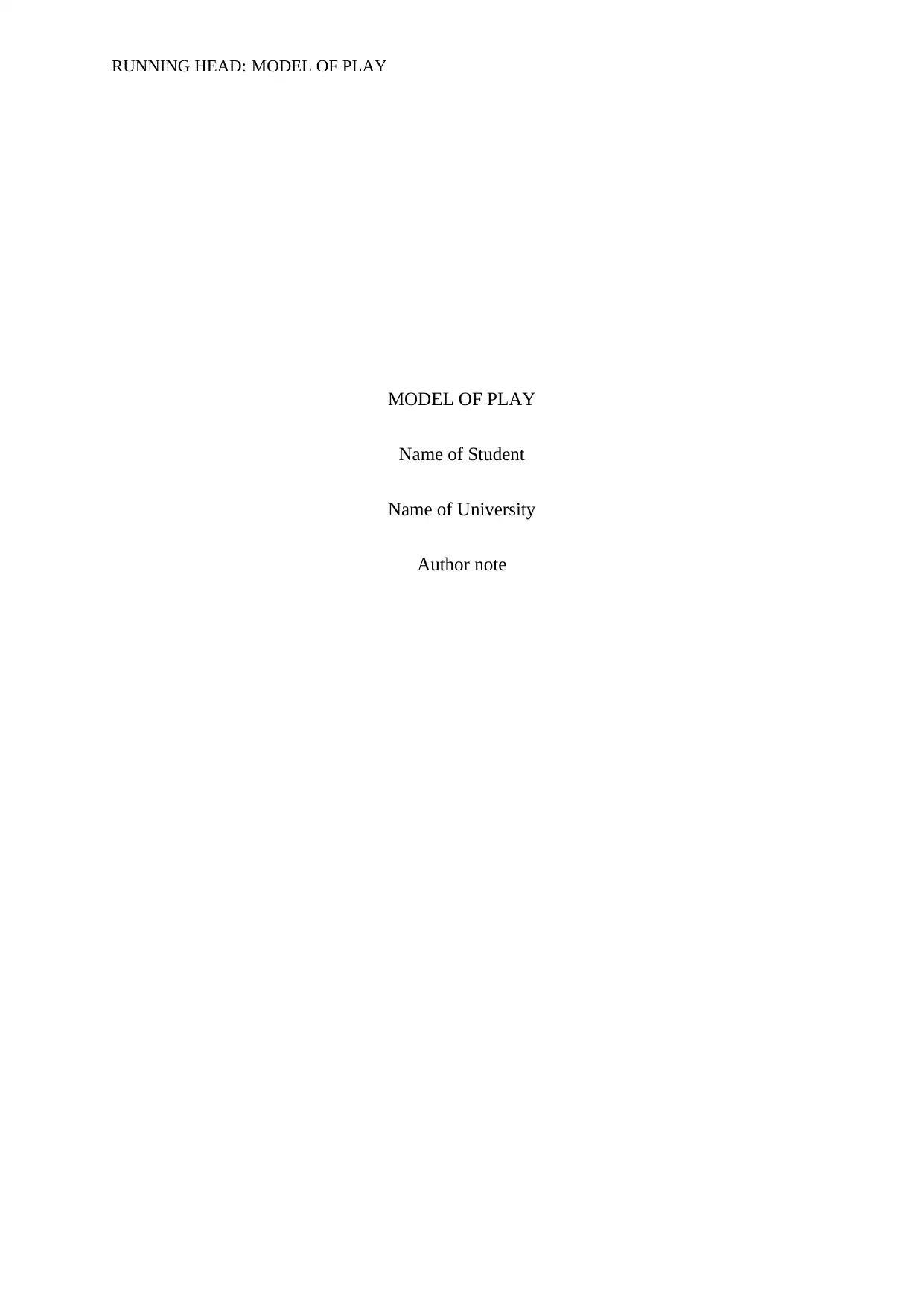
RUNNING HEAD: MODEL OF PLAY
MODEL OF PLAY
Name of Student
Name of University
Author note
MODEL OF PLAY
Name of Student
Name of University
Author note
Paraphrase This Document
Need a fresh take? Get an instant paraphrase of this document with our AI Paraphraser
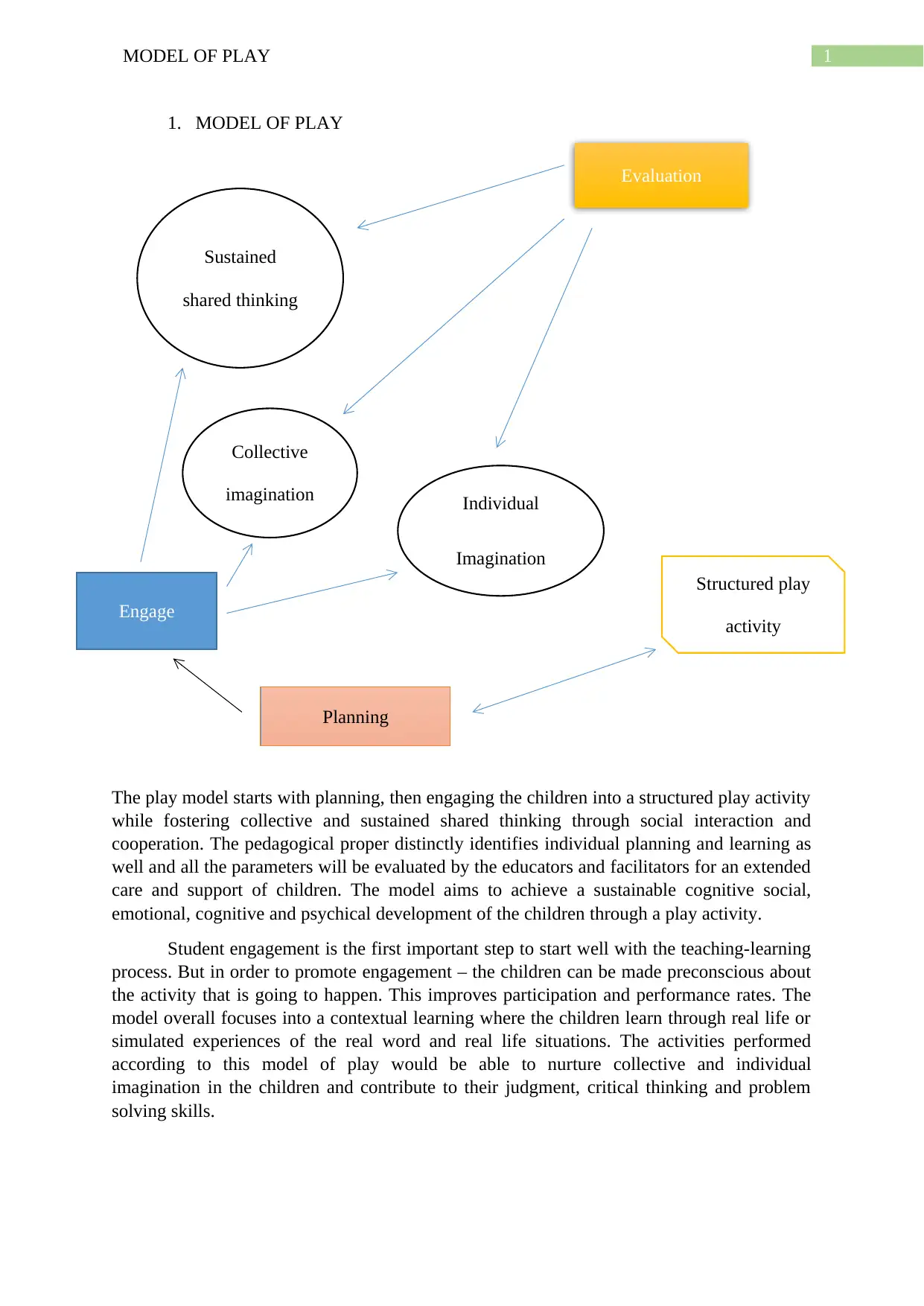
1MODEL OF PLAY
1. MODEL OF PLAY
The play model starts with planning, then engaging the children into a structured play activity
while fostering collective and sustained shared thinking through social interaction and
cooperation. The pedagogical proper distinctly identifies individual planning and learning as
well and all the parameters will be evaluated by the educators and facilitators for an extended
care and support of children. The model aims to achieve a sustainable cognitive social,
emotional, cognitive and psychical development of the children through a play activity.
Student engagement is the first important step to start well with the teaching-learning
process. But in order to promote engagement – the children can be made preconscious about
the activity that is going to happen. This improves participation and performance rates. The
model overall focuses into a contextual learning where the children learn through real life or
simulated experiences of the real word and real life situations. The activities performed
according to this model of play would be able to nurture collective and individual
imagination in the children and contribute to their judgment, critical thinking and problem
solving skills.
Sustained
shared thinking
Collective
imagination Individual
Imagination
Evaluation
Engage
Planning
Structured play
activity
1. MODEL OF PLAY
The play model starts with planning, then engaging the children into a structured play activity
while fostering collective and sustained shared thinking through social interaction and
cooperation. The pedagogical proper distinctly identifies individual planning and learning as
well and all the parameters will be evaluated by the educators and facilitators for an extended
care and support of children. The model aims to achieve a sustainable cognitive social,
emotional, cognitive and psychical development of the children through a play activity.
Student engagement is the first important step to start well with the teaching-learning
process. But in order to promote engagement – the children can be made preconscious about
the activity that is going to happen. This improves participation and performance rates. The
model overall focuses into a contextual learning where the children learn through real life or
simulated experiences of the real word and real life situations. The activities performed
according to this model of play would be able to nurture collective and individual
imagination in the children and contribute to their judgment, critical thinking and problem
solving skills.
Sustained
shared thinking
Collective
imagination Individual
Imagination
Evaluation
Engage
Planning
Structured play
activity
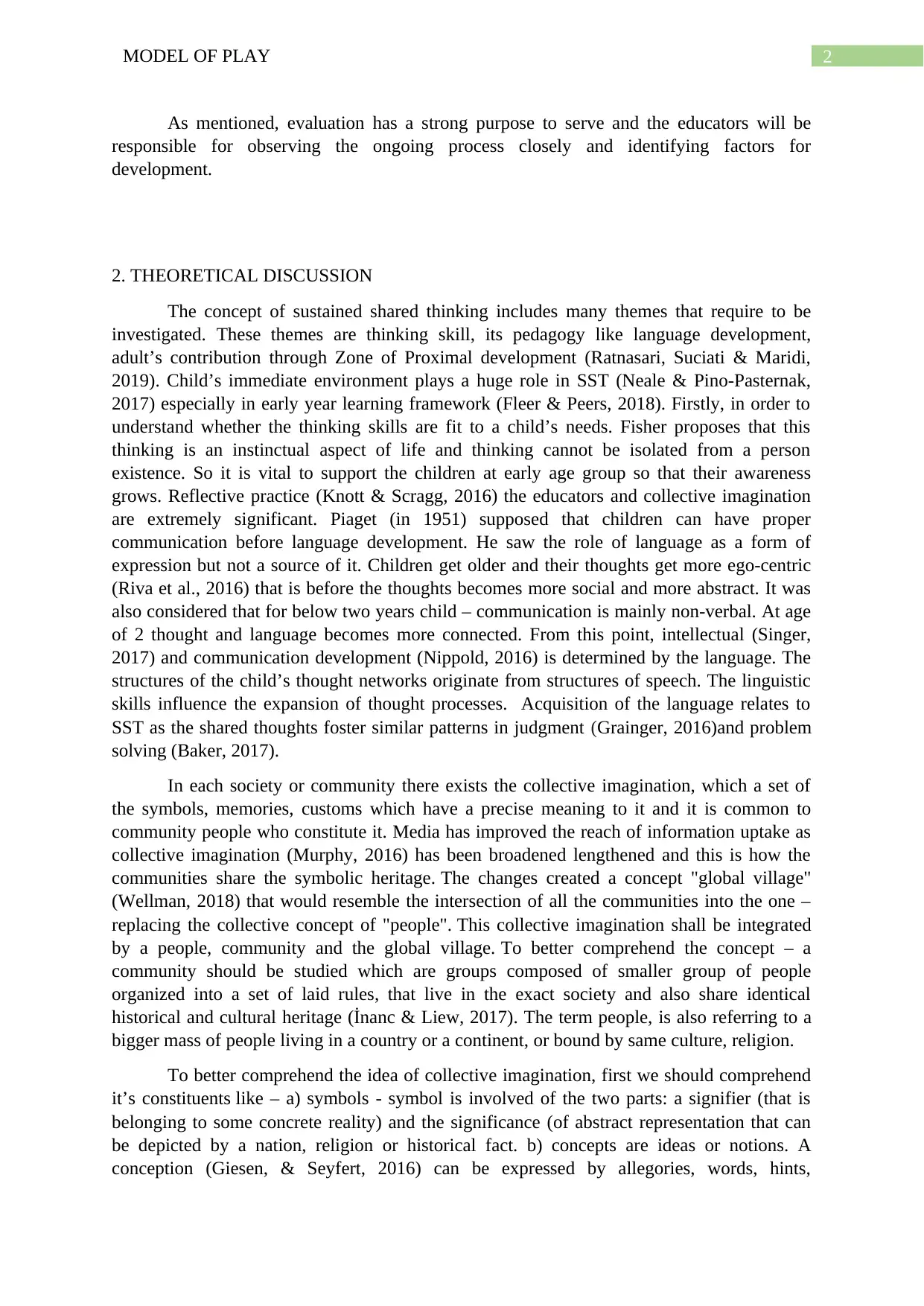
2MODEL OF PLAY
As mentioned, evaluation has a strong purpose to serve and the educators will be
responsible for observing the ongoing process closely and identifying factors for
development.
2. THEORETICAL DISCUSSION
The concept of sustained shared thinking includes many themes that require to be
investigated. These themes are thinking skill, its pedagogy like language development,
adult’s contribution through Zone of Proximal development (Ratnasari, Suciati & Maridi,
2019). Child’s immediate environment plays a huge role in SST (Neale & Pino-Pasternak,
2017) especially in early year learning framework (Fleer & Peers, 2018). Firstly, in order to
understand whether the thinking skills are fit to a child’s needs. Fisher proposes that this
thinking is an instinctual aspect of life and thinking cannot be isolated from a person
existence. So it is vital to support the children at early age group so that their awareness
grows. Reflective practice (Knott & Scragg, 2016) the educators and collective imagination
are extremely significant. Piaget (in 1951) supposed that children can have proper
communication before language development. He saw the role of language as a form of
expression but not a source of it. Children get older and their thoughts get more ego-centric
(Riva et al., 2016) that is before the thoughts becomes more social and more abstract. It was
also considered that for below two years child – communication is mainly non-verbal. At age
of 2 thought and language becomes more connected. From this point, intellectual (Singer,
2017) and communication development (Nippold, 2016) is determined by the language. The
structures of the child’s thought networks originate from structures of speech. The linguistic
skills influence the expansion of thought processes. Acquisition of the language relates to
SST as the shared thoughts foster similar patterns in judgment (Grainger, 2016)and problem
solving (Baker, 2017).
In each society or community there exists the collective imagination, which a set of
the symbols, memories, customs which have a precise meaning to it and it is common to
community people who constitute it. Media has improved the reach of information uptake as
collective imagination (Murphy, 2016) has been broadened lengthened and this is how the
communities share the symbolic heritage. The changes created a concept "global village"
(Wellman, 2018) that would resemble the intersection of all the communities into the one –
replacing the collective concept of "people". This collective imagination shall be integrated
by a people, community and the global village. To better comprehend the concept – a
community should be studied which are groups composed of smaller group of people
organized into a set of laid rules, that live in the exact society and also share identical
historical and cultural heritage (İnanc & Liew, 2017). The term people, is also referring to a
bigger mass of people living in a country or a continent, or bound by same culture, religion.
To better comprehend the idea of collective imagination, first we should comprehend
it’s constituents like – a) symbols - symbol is involved of the two parts: a signifier (that is
belonging to some concrete reality) and the significance (of abstract representation that can
be depicted by a nation, religion or historical fact. b) concepts are ideas or notions. A
conception (Giesen, & Seyfert, 2016) can be expressed by allegories, words, hints,
As mentioned, evaluation has a strong purpose to serve and the educators will be
responsible for observing the ongoing process closely and identifying factors for
development.
2. THEORETICAL DISCUSSION
The concept of sustained shared thinking includes many themes that require to be
investigated. These themes are thinking skill, its pedagogy like language development,
adult’s contribution through Zone of Proximal development (Ratnasari, Suciati & Maridi,
2019). Child’s immediate environment plays a huge role in SST (Neale & Pino-Pasternak,
2017) especially in early year learning framework (Fleer & Peers, 2018). Firstly, in order to
understand whether the thinking skills are fit to a child’s needs. Fisher proposes that this
thinking is an instinctual aspect of life and thinking cannot be isolated from a person
existence. So it is vital to support the children at early age group so that their awareness
grows. Reflective practice (Knott & Scragg, 2016) the educators and collective imagination
are extremely significant. Piaget (in 1951) supposed that children can have proper
communication before language development. He saw the role of language as a form of
expression but not a source of it. Children get older and their thoughts get more ego-centric
(Riva et al., 2016) that is before the thoughts becomes more social and more abstract. It was
also considered that for below two years child – communication is mainly non-verbal. At age
of 2 thought and language becomes more connected. From this point, intellectual (Singer,
2017) and communication development (Nippold, 2016) is determined by the language. The
structures of the child’s thought networks originate from structures of speech. The linguistic
skills influence the expansion of thought processes. Acquisition of the language relates to
SST as the shared thoughts foster similar patterns in judgment (Grainger, 2016)and problem
solving (Baker, 2017).
In each society or community there exists the collective imagination, which a set of
the symbols, memories, customs which have a precise meaning to it and it is common to
community people who constitute it. Media has improved the reach of information uptake as
collective imagination (Murphy, 2016) has been broadened lengthened and this is how the
communities share the symbolic heritage. The changes created a concept "global village"
(Wellman, 2018) that would resemble the intersection of all the communities into the one –
replacing the collective concept of "people". This collective imagination shall be integrated
by a people, community and the global village. To better comprehend the concept – a
community should be studied which are groups composed of smaller group of people
organized into a set of laid rules, that live in the exact society and also share identical
historical and cultural heritage (İnanc & Liew, 2017). The term people, is also referring to a
bigger mass of people living in a country or a continent, or bound by same culture, religion.
To better comprehend the idea of collective imagination, first we should comprehend
it’s constituents like – a) symbols - symbol is involved of the two parts: a signifier (that is
belonging to some concrete reality) and the significance (of abstract representation that can
be depicted by a nation, religion or historical fact. b) concepts are ideas or notions. A
conception (Giesen, & Seyfert, 2016) can be expressed by allegories, words, hints,
⊘ This is a preview!⊘
Do you want full access?
Subscribe today to unlock all pages.

Trusted by 1+ million students worldwide
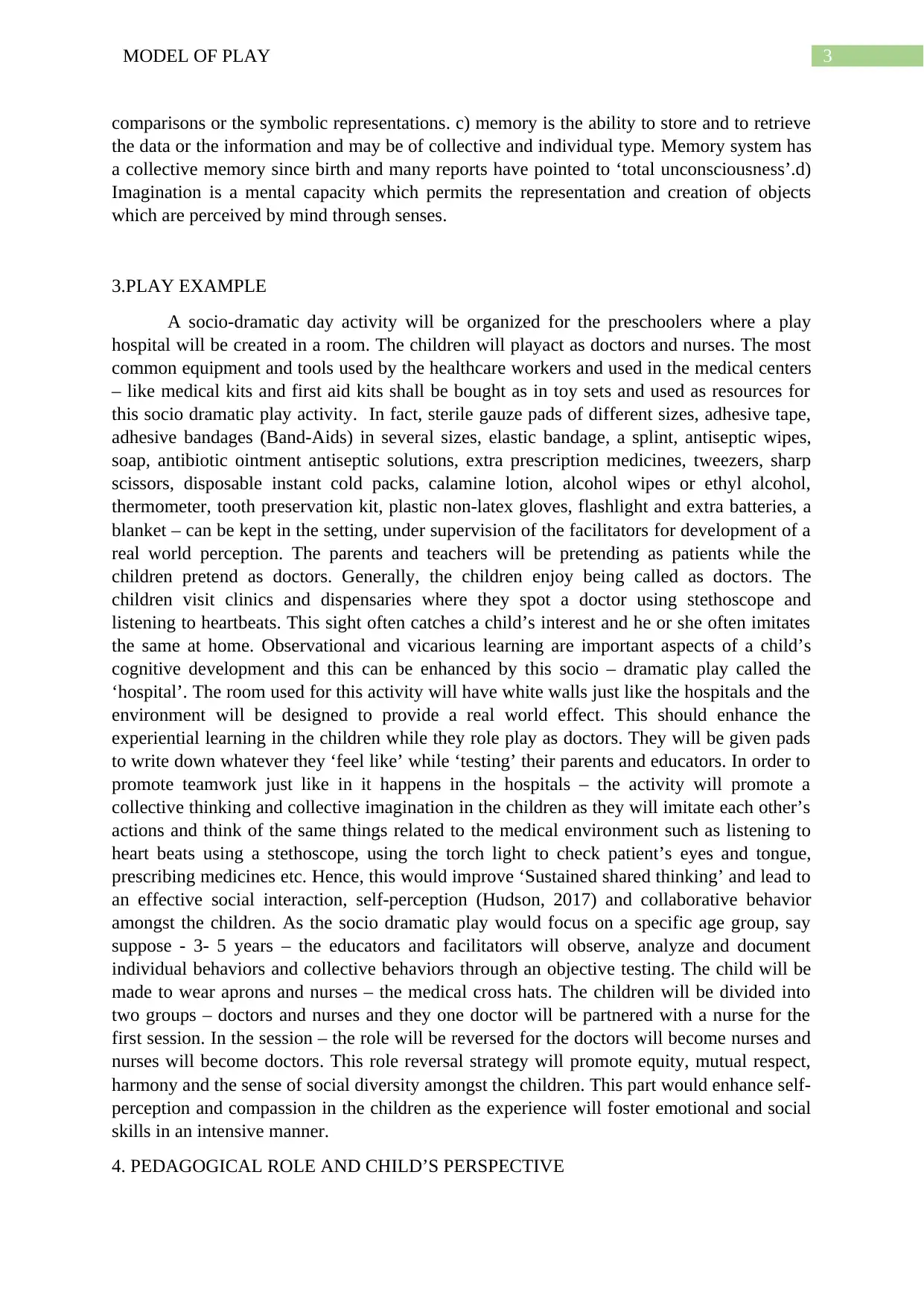
3MODEL OF PLAY
comparisons or the symbolic representations. c) memory is the ability to store and to retrieve
the data or the information and may be of collective and individual type. Memory system has
a collective memory since birth and many reports have pointed to ‘total unconsciousness’.d)
Imagination is a mental capacity which permits the representation and creation of objects
which are perceived by mind through senses.
3.PLAY EXAMPLE
A socio-dramatic day activity will be organized for the preschoolers where a play
hospital will be created in a room. The children will playact as doctors and nurses. The most
common equipment and tools used by the healthcare workers and used in the medical centers
– like medical kits and first aid kits shall be bought as in toy sets and used as resources for
this socio dramatic play activity. In fact, sterile gauze pads of different sizes, adhesive tape,
adhesive bandages (Band-Aids) in several sizes, elastic bandage, a splint, antiseptic wipes,
soap, antibiotic ointment antiseptic solutions, extra prescription medicines, tweezers, sharp
scissors, disposable instant cold packs, calamine lotion, alcohol wipes or ethyl alcohol,
thermometer, tooth preservation kit, plastic non-latex gloves, flashlight and extra batteries, a
blanket – can be kept in the setting, under supervision of the facilitators for development of a
real world perception. The parents and teachers will be pretending as patients while the
children pretend as doctors. Generally, the children enjoy being called as doctors. The
children visit clinics and dispensaries where they spot a doctor using stethoscope and
listening to heartbeats. This sight often catches a child’s interest and he or she often imitates
the same at home. Observational and vicarious learning are important aspects of a child’s
cognitive development and this can be enhanced by this socio – dramatic play called the
‘hospital’. The room used for this activity will have white walls just like the hospitals and the
environment will be designed to provide a real world effect. This should enhance the
experiential learning in the children while they role play as doctors. They will be given pads
to write down whatever they ‘feel like’ while ‘testing’ their parents and educators. In order to
promote teamwork just like in it happens in the hospitals – the activity will promote a
collective thinking and collective imagination in the children as they will imitate each other’s
actions and think of the same things related to the medical environment such as listening to
heart beats using a stethoscope, using the torch light to check patient’s eyes and tongue,
prescribing medicines etc. Hence, this would improve ‘Sustained shared thinking’ and lead to
an effective social interaction, self-perception (Hudson, 2017) and collaborative behavior
amongst the children. As the socio dramatic play would focus on a specific age group, say
suppose - 3- 5 years – the educators and facilitators will observe, analyze and document
individual behaviors and collective behaviors through an objective testing. The child will be
made to wear aprons and nurses – the medical cross hats. The children will be divided into
two groups – doctors and nurses and they one doctor will be partnered with a nurse for the
first session. In the session – the role will be reversed for the doctors will become nurses and
nurses will become doctors. This role reversal strategy will promote equity, mutual respect,
harmony and the sense of social diversity amongst the children. This part would enhance self-
perception and compassion in the children as the experience will foster emotional and social
skills in an intensive manner.
4. PEDAGOGICAL ROLE AND CHILD’S PERSPECTIVE
comparisons or the symbolic representations. c) memory is the ability to store and to retrieve
the data or the information and may be of collective and individual type. Memory system has
a collective memory since birth and many reports have pointed to ‘total unconsciousness’.d)
Imagination is a mental capacity which permits the representation and creation of objects
which are perceived by mind through senses.
3.PLAY EXAMPLE
A socio-dramatic day activity will be organized for the preschoolers where a play
hospital will be created in a room. The children will playact as doctors and nurses. The most
common equipment and tools used by the healthcare workers and used in the medical centers
– like medical kits and first aid kits shall be bought as in toy sets and used as resources for
this socio dramatic play activity. In fact, sterile gauze pads of different sizes, adhesive tape,
adhesive bandages (Band-Aids) in several sizes, elastic bandage, a splint, antiseptic wipes,
soap, antibiotic ointment antiseptic solutions, extra prescription medicines, tweezers, sharp
scissors, disposable instant cold packs, calamine lotion, alcohol wipes or ethyl alcohol,
thermometer, tooth preservation kit, plastic non-latex gloves, flashlight and extra batteries, a
blanket – can be kept in the setting, under supervision of the facilitators for development of a
real world perception. The parents and teachers will be pretending as patients while the
children pretend as doctors. Generally, the children enjoy being called as doctors. The
children visit clinics and dispensaries where they spot a doctor using stethoscope and
listening to heartbeats. This sight often catches a child’s interest and he or she often imitates
the same at home. Observational and vicarious learning are important aspects of a child’s
cognitive development and this can be enhanced by this socio – dramatic play called the
‘hospital’. The room used for this activity will have white walls just like the hospitals and the
environment will be designed to provide a real world effect. This should enhance the
experiential learning in the children while they role play as doctors. They will be given pads
to write down whatever they ‘feel like’ while ‘testing’ their parents and educators. In order to
promote teamwork just like in it happens in the hospitals – the activity will promote a
collective thinking and collective imagination in the children as they will imitate each other’s
actions and think of the same things related to the medical environment such as listening to
heart beats using a stethoscope, using the torch light to check patient’s eyes and tongue,
prescribing medicines etc. Hence, this would improve ‘Sustained shared thinking’ and lead to
an effective social interaction, self-perception (Hudson, 2017) and collaborative behavior
amongst the children. As the socio dramatic play would focus on a specific age group, say
suppose - 3- 5 years – the educators and facilitators will observe, analyze and document
individual behaviors and collective behaviors through an objective testing. The child will be
made to wear aprons and nurses – the medical cross hats. The children will be divided into
two groups – doctors and nurses and they one doctor will be partnered with a nurse for the
first session. In the session – the role will be reversed for the doctors will become nurses and
nurses will become doctors. This role reversal strategy will promote equity, mutual respect,
harmony and the sense of social diversity amongst the children. This part would enhance self-
perception and compassion in the children as the experience will foster emotional and social
skills in an intensive manner.
4. PEDAGOGICAL ROLE AND CHILD’S PERSPECTIVE
Paraphrase This Document
Need a fresh take? Get an instant paraphrase of this document with our AI Paraphraser
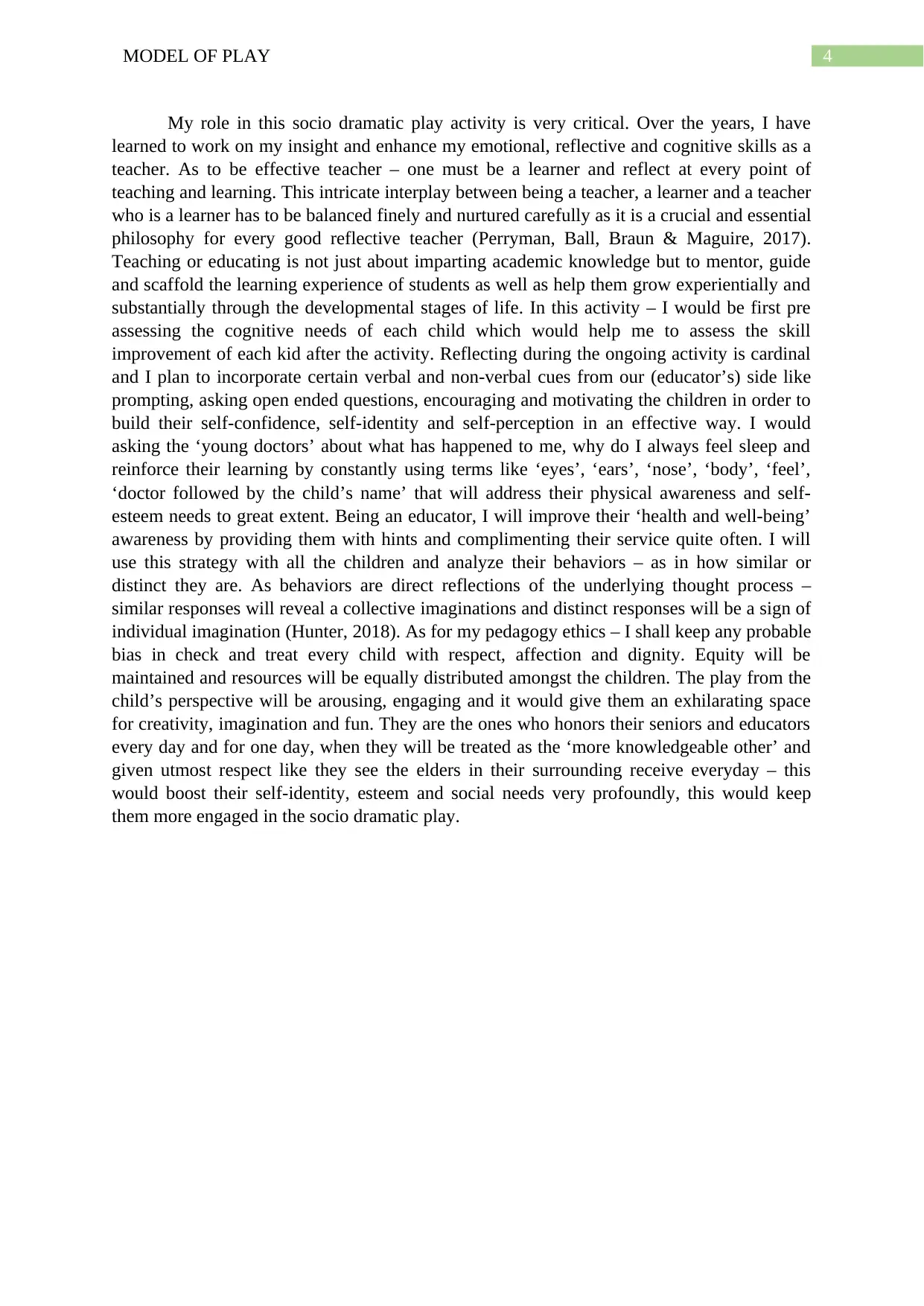
4MODEL OF PLAY
My role in this socio dramatic play activity is very critical. Over the years, I have
learned to work on my insight and enhance my emotional, reflective and cognitive skills as a
teacher. As to be effective teacher – one must be a learner and reflect at every point of
teaching and learning. This intricate interplay between being a teacher, a learner and a teacher
who is a learner has to be balanced finely and nurtured carefully as it is a crucial and essential
philosophy for every good reflective teacher (Perryman, Ball, Braun & Maguire, 2017).
Teaching or educating is not just about imparting academic knowledge but to mentor, guide
and scaffold the learning experience of students as well as help them grow experientially and
substantially through the developmental stages of life. In this activity – I would be first pre
assessing the cognitive needs of each child which would help me to assess the skill
improvement of each kid after the activity. Reflecting during the ongoing activity is cardinal
and I plan to incorporate certain verbal and non-verbal cues from our (educator’s) side like
prompting, asking open ended questions, encouraging and motivating the children in order to
build their self-confidence, self-identity and self-perception in an effective way. I would
asking the ‘young doctors’ about what has happened to me, why do I always feel sleep and
reinforce their learning by constantly using terms like ‘eyes’, ‘ears’, ‘nose’, ‘body’, ‘feel’,
‘doctor followed by the child’s name’ that will address their physical awareness and self-
esteem needs to great extent. Being an educator, I will improve their ‘health and well-being’
awareness by providing them with hints and complimenting their service quite often. I will
use this strategy with all the children and analyze their behaviors – as in how similar or
distinct they are. As behaviors are direct reflections of the underlying thought process –
similar responses will reveal a collective imaginations and distinct responses will be a sign of
individual imagination (Hunter, 2018). As for my pedagogy ethics – I shall keep any probable
bias in check and treat every child with respect, affection and dignity. Equity will be
maintained and resources will be equally distributed amongst the children. The play from the
child’s perspective will be arousing, engaging and it would give them an exhilarating space
for creativity, imagination and fun. They are the ones who honors their seniors and educators
every day and for one day, when they will be treated as the ‘more knowledgeable other’ and
given utmost respect like they see the elders in their surrounding receive everyday – this
would boost their self-identity, esteem and social needs very profoundly, this would keep
them more engaged in the socio dramatic play.
My role in this socio dramatic play activity is very critical. Over the years, I have
learned to work on my insight and enhance my emotional, reflective and cognitive skills as a
teacher. As to be effective teacher – one must be a learner and reflect at every point of
teaching and learning. This intricate interplay between being a teacher, a learner and a teacher
who is a learner has to be balanced finely and nurtured carefully as it is a crucial and essential
philosophy for every good reflective teacher (Perryman, Ball, Braun & Maguire, 2017).
Teaching or educating is not just about imparting academic knowledge but to mentor, guide
and scaffold the learning experience of students as well as help them grow experientially and
substantially through the developmental stages of life. In this activity – I would be first pre
assessing the cognitive needs of each child which would help me to assess the skill
improvement of each kid after the activity. Reflecting during the ongoing activity is cardinal
and I plan to incorporate certain verbal and non-verbal cues from our (educator’s) side like
prompting, asking open ended questions, encouraging and motivating the children in order to
build their self-confidence, self-identity and self-perception in an effective way. I would
asking the ‘young doctors’ about what has happened to me, why do I always feel sleep and
reinforce their learning by constantly using terms like ‘eyes’, ‘ears’, ‘nose’, ‘body’, ‘feel’,
‘doctor followed by the child’s name’ that will address their physical awareness and self-
esteem needs to great extent. Being an educator, I will improve their ‘health and well-being’
awareness by providing them with hints and complimenting their service quite often. I will
use this strategy with all the children and analyze their behaviors – as in how similar or
distinct they are. As behaviors are direct reflections of the underlying thought process –
similar responses will reveal a collective imaginations and distinct responses will be a sign of
individual imagination (Hunter, 2018). As for my pedagogy ethics – I shall keep any probable
bias in check and treat every child with respect, affection and dignity. Equity will be
maintained and resources will be equally distributed amongst the children. The play from the
child’s perspective will be arousing, engaging and it would give them an exhilarating space
for creativity, imagination and fun. They are the ones who honors their seniors and educators
every day and for one day, when they will be treated as the ‘more knowledgeable other’ and
given utmost respect like they see the elders in their surrounding receive everyday – this
would boost their self-identity, esteem and social needs very profoundly, this would keep
them more engaged in the socio dramatic play.
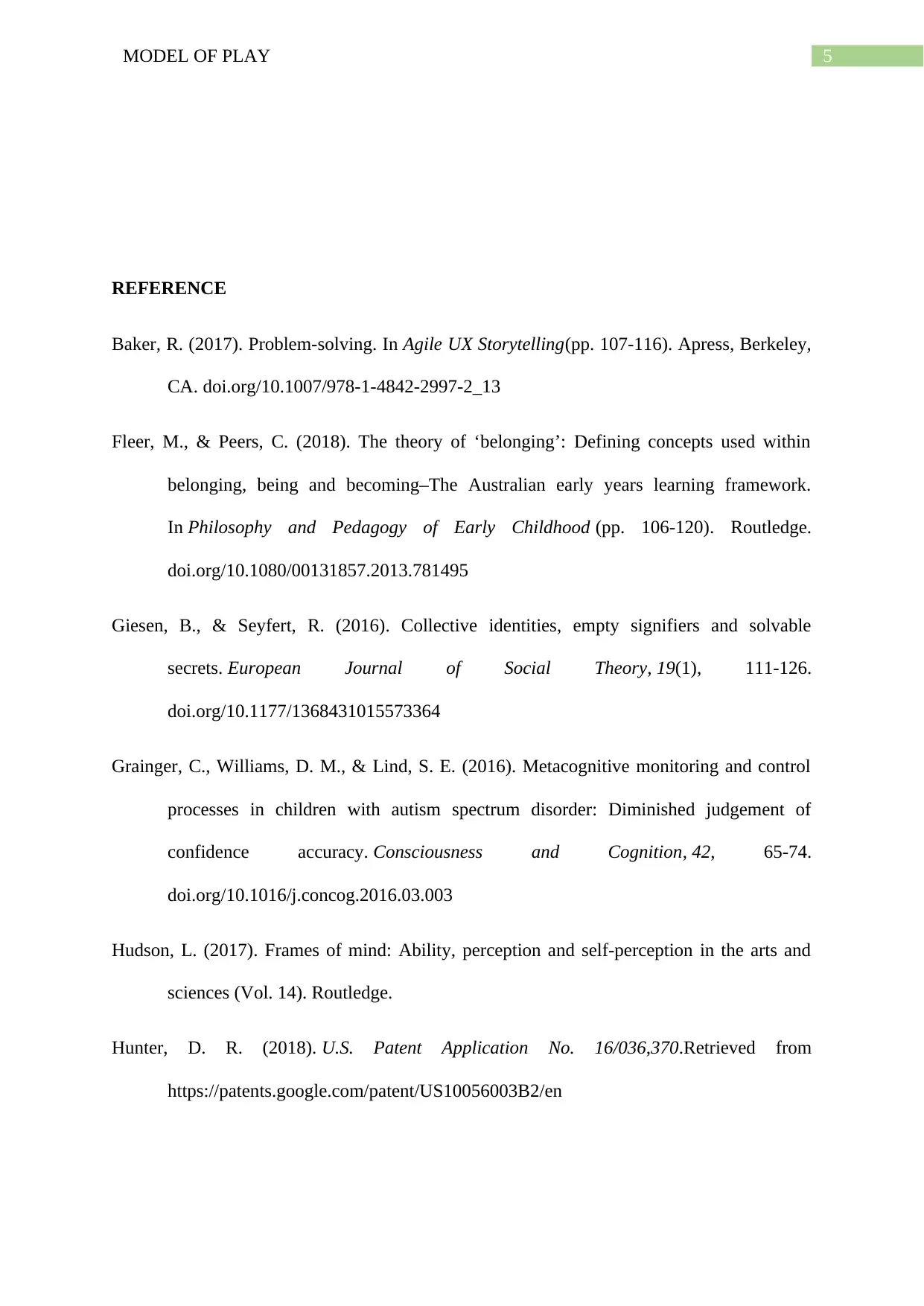
5MODEL OF PLAY
REFERENCE
Baker, R. (2017). Problem-solving. In Agile UX Storytelling(pp. 107-116). Apress, Berkeley,
CA. doi.org/10.1007/978-1-4842-2997-2_13
Fleer, M., & Peers, C. (2018). The theory of ‘belonging’: Defining concepts used within
belonging, being and becoming–The Australian early years learning framework.
In Philosophy and Pedagogy of Early Childhood (pp. 106-120). Routledge.
doi.org/10.1080/00131857.2013.781495
Giesen, B., & Seyfert, R. (2016). Collective identities, empty signifiers and solvable
secrets. European Journal of Social Theory, 19(1), 111-126.
doi.org/10.1177/1368431015573364
Grainger, C., Williams, D. M., & Lind, S. E. (2016). Metacognitive monitoring and control
processes in children with autism spectrum disorder: Diminished judgement of
confidence accuracy. Consciousness and Cognition, 42, 65-74.
doi.org/10.1016/j.concog.2016.03.003
Hudson, L. (2017). Frames of mind: Ability, perception and self-perception in the arts and
sciences (Vol. 14). Routledge.
Hunter, D. R. (2018). U.S. Patent Application No. 16/036,370.Retrieved from
https://patents.google.com/patent/US10056003B2/en
REFERENCE
Baker, R. (2017). Problem-solving. In Agile UX Storytelling(pp. 107-116). Apress, Berkeley,
CA. doi.org/10.1007/978-1-4842-2997-2_13
Fleer, M., & Peers, C. (2018). The theory of ‘belonging’: Defining concepts used within
belonging, being and becoming–The Australian early years learning framework.
In Philosophy and Pedagogy of Early Childhood (pp. 106-120). Routledge.
doi.org/10.1080/00131857.2013.781495
Giesen, B., & Seyfert, R. (2016). Collective identities, empty signifiers and solvable
secrets. European Journal of Social Theory, 19(1), 111-126.
doi.org/10.1177/1368431015573364
Grainger, C., Williams, D. M., & Lind, S. E. (2016). Metacognitive monitoring and control
processes in children with autism spectrum disorder: Diminished judgement of
confidence accuracy. Consciousness and Cognition, 42, 65-74.
doi.org/10.1016/j.concog.2016.03.003
Hudson, L. (2017). Frames of mind: Ability, perception and self-perception in the arts and
sciences (Vol. 14). Routledge.
Hunter, D. R. (2018). U.S. Patent Application No. 16/036,370.Retrieved from
https://patents.google.com/patent/US10056003B2/en
⊘ This is a preview!⊘
Do you want full access?
Subscribe today to unlock all pages.

Trusted by 1+ million students worldwide
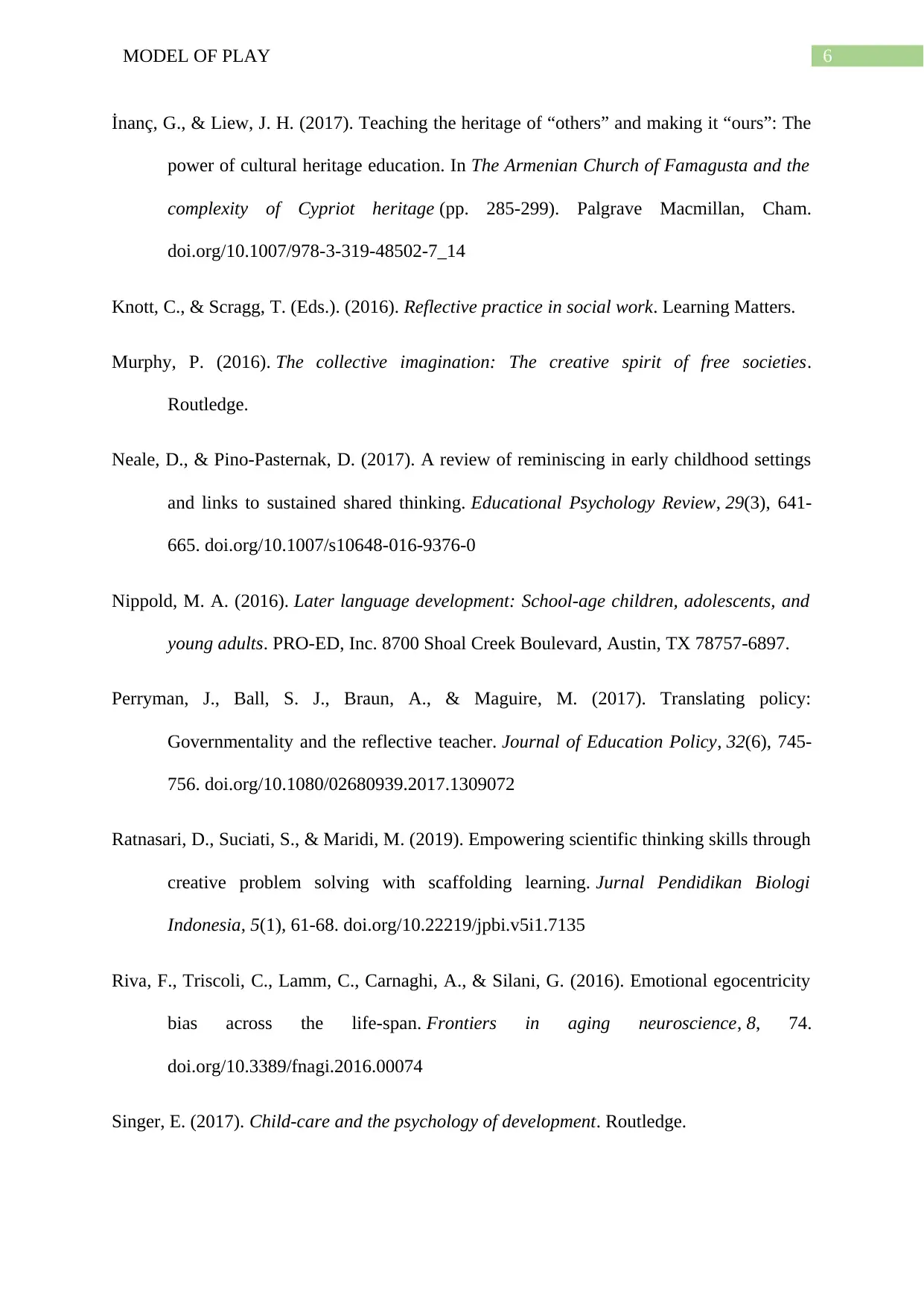
6MODEL OF PLAY
İnanç, G., & Liew, J. H. (2017). Teaching the heritage of “others” and making it “ours”: The
power of cultural heritage education. In The Armenian Church of Famagusta and the
complexity of Cypriot heritage (pp. 285-299). Palgrave Macmillan, Cham.
doi.org/10.1007/978-3-319-48502-7_14
Knott, C., & Scragg, T. (Eds.). (2016). Reflective practice in social work. Learning Matters.
Murphy, P. (2016). The collective imagination: The creative spirit of free societies.
Routledge.
Neale, D., & Pino-Pasternak, D. (2017). A review of reminiscing in early childhood settings
and links to sustained shared thinking. Educational Psychology Review, 29(3), 641-
665. doi.org/10.1007/s10648-016-9376-0
Nippold, M. A. (2016). Later language development: School-age children, adolescents, and
young adults. PRO-ED, Inc. 8700 Shoal Creek Boulevard, Austin, TX 78757-6897.
Perryman, J., Ball, S. J., Braun, A., & Maguire, M. (2017). Translating policy:
Governmentality and the reflective teacher. Journal of Education Policy, 32(6), 745-
756. doi.org/10.1080/02680939.2017.1309072
Ratnasari, D., Suciati, S., & Maridi, M. (2019). Empowering scientific thinking skills through
creative problem solving with scaffolding learning. Jurnal Pendidikan Biologi
Indonesia, 5(1), 61-68. doi.org/10.22219/jpbi.v5i1.7135
Riva, F., Triscoli, C., Lamm, C., Carnaghi, A., & Silani, G. (2016). Emotional egocentricity
bias across the life-span. Frontiers in aging neuroscience, 8, 74.
doi.org/10.3389/fnagi.2016.00074
Singer, E. (2017). Child-care and the psychology of development. Routledge.
İnanç, G., & Liew, J. H. (2017). Teaching the heritage of “others” and making it “ours”: The
power of cultural heritage education. In The Armenian Church of Famagusta and the
complexity of Cypriot heritage (pp. 285-299). Palgrave Macmillan, Cham.
doi.org/10.1007/978-3-319-48502-7_14
Knott, C., & Scragg, T. (Eds.). (2016). Reflective practice in social work. Learning Matters.
Murphy, P. (2016). The collective imagination: The creative spirit of free societies.
Routledge.
Neale, D., & Pino-Pasternak, D. (2017). A review of reminiscing in early childhood settings
and links to sustained shared thinking. Educational Psychology Review, 29(3), 641-
665. doi.org/10.1007/s10648-016-9376-0
Nippold, M. A. (2016). Later language development: School-age children, adolescents, and
young adults. PRO-ED, Inc. 8700 Shoal Creek Boulevard, Austin, TX 78757-6897.
Perryman, J., Ball, S. J., Braun, A., & Maguire, M. (2017). Translating policy:
Governmentality and the reflective teacher. Journal of Education Policy, 32(6), 745-
756. doi.org/10.1080/02680939.2017.1309072
Ratnasari, D., Suciati, S., & Maridi, M. (2019). Empowering scientific thinking skills through
creative problem solving with scaffolding learning. Jurnal Pendidikan Biologi
Indonesia, 5(1), 61-68. doi.org/10.22219/jpbi.v5i1.7135
Riva, F., Triscoli, C., Lamm, C., Carnaghi, A., & Silani, G. (2016). Emotional egocentricity
bias across the life-span. Frontiers in aging neuroscience, 8, 74.
doi.org/10.3389/fnagi.2016.00074
Singer, E. (2017). Child-care and the psychology of development. Routledge.
Paraphrase This Document
Need a fresh take? Get an instant paraphrase of this document with our AI Paraphraser

7MODEL OF PLAY
Wellman, B. (2018). Networks in the global village: Life in contemporary communities.
Routledge.
Wellman, B. (2018). Networks in the global village: Life in contemporary communities.
Routledge.
1 out of 8
Related Documents
Your All-in-One AI-Powered Toolkit for Academic Success.
+13062052269
info@desklib.com
Available 24*7 on WhatsApp / Email
![[object Object]](/_next/static/media/star-bottom.7253800d.svg)
Unlock your academic potential
Copyright © 2020–2025 A2Z Services. All Rights Reserved. Developed and managed by ZUCOL.





